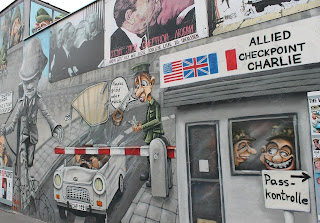The Cold War History || The Effects Of The Cold War ||
In this blog, I will tell you about The History Of The Cold War and The Effects Of The Cold War On The World.
.The Cold War: Containment
By World War II finished, most American authorities had
concurred that the best guard against the Soviet danger was a procedure called
"control." In his renowned "Long Telegram," the
representative George Kennan (1904-2005) made sense of the strategy: The Soviet
Union, he composed, was "a political power committed fanatically to the
conviction that with the U.S. there can be no long-lasting modus vivendi
[agreement between parties that disagree]." subsequently, America's just
decision was the "long haul, patient yet firm and careful regulation of
Russian sweeping propensities." "It should be the approach of the
United States," he announced before Congress in 1947, "to help free
people groups who are opposing endeavored enslavement… by outside
pressures." This perspective would shape American international strategy
for the following forty years.
.The Cold War: The Atomic Age
The control procedure likewise gave the reasoning to a
remarkable arms development in the United States. In 1950, a National Security
Council Report known as NSC-68 repeated Truman's proposal that the nation
utilizes military power to contain socialist expansionism anyplace it was by
all accounts happening. Keeping that in mind, the report required a
four-overlap expansion in guard spending.
Specifically, American authorities supported the advancement
of nuclear weapons like the ones that had finished World War II. Consequently
started a lethal "weapons contest." In 1949, the Soviets tried their
very own nuclear bomb. Accordingly, President Truman reported that the United
States would construct a significantly more disastrous nuclear weapon: the
nuclear bomb, or "super bomb." Stalin went with the same pattern.
Accordingly, the stakes of the Cold War were dangerously
high. The primary H-bomb test, in the Eniwetok atoll in the Marshall Islands,
showed exactly how fearsome the atomic age could be. It made a
25-square-mile fireball that disintegrated an island, blew a gigantic opening
in the sea depths, and could obliterate a portion of Manhattan.
Resulting in American and Soviet tests regurgitating radioactive waste into the
climate.
.The Cold War and the Space Race
In 1958, the U.S. sent off its own satellite, Explorer I,
planned by the U.S. Armed force under the heading of scientific genius Werner
von Braun, and what came to be known as the Space Race was in progress. That
very year, President Dwight Eisenhower marked a public request making the
National Aeronautics and Space Administration (NASA), a government organization
devoted to space investigation, as well as a few projects looking to take
advantage of the tactical capability of room. In any case, the Soviets were one
stride ahead, sending off the initial man into space in April 1961.
.The End of the Cold War and its Effects
Nearly when he got to work, President Richard Nixon
(1913-1994) started to execute another way to deal with global relations.
Rather than survey the world as a threatening, "bi-polar" place, he
recommended, why not use strategy rather than a military activity to make more
posts? Keeping that in mind, he urged the United Nations to perceive the
socialist Chinese government and, after an excursion there in 1972, started to
lay out conciliatory relations with Beijing. Simultaneously, he took on a strategy
of "détente"- " unwinding"- close to the Soviet Union. In
1972, he and Soviet chief Leonid Brezhnev (1906-1982) marked the Strategic Arms
Limitation Treaty (SALT I), which restricted the production of atomic rockets
by the two sides and moved toward decreasing the many years old danger of
atomic conflict.
Despite Nixon's endeavors, the Cold War warmed up again under President Ronald Reagan (1911-2004). In the same way as other heads of his age, Reagan accepted that the spread of socialism anyplace compromised opportunity all over the place. Thus, he attempted to give monetary and military guidance to anticommunist legislatures and rebellions all over the planet.
This arrangement, especially as it was applied in the creation scene in
places like Grenada and El Salvador, was known as the Reagan Doctrine. Soviet
impact in Eastern Europe faded. In 1989, each and every socialist state in the
locale supplanted its administration with a noncommunist one. In November of
that year, the Berlin Wall-the most noticeable image of the long-term Cold
War-was at last obliterated, a little more than two years after Reagan had
tested the Soviet chief in a discourse at Brandenburg Gate in Berlin: "Mr.
Gorbachev, destroy this wall." By 1991, the Soviet Union itself had self-destructed.
The Cold War was finished.


.jpg)
.jpg)
.jpg)
.jpg)
.jpg)
.jpg)




0 Comments
If you want me to publish history that you like so tell me freely...